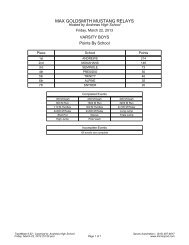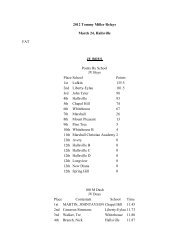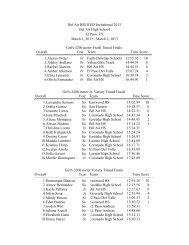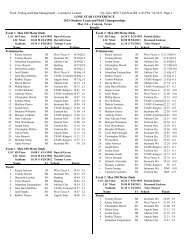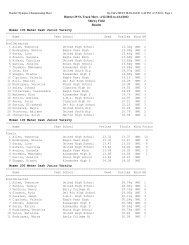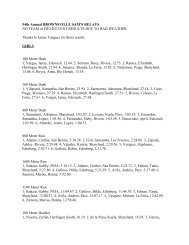1. PAGES 1-35 - Texas Track & Field Coaches Association
1. PAGES 1-35 - Texas Track & Field Coaches Association
1. PAGES 1-35 - Texas Track & Field Coaches Association
Create successful ePaper yourself
Turn your PDF publications into a flip-book with our unique Google optimized e-Paper software.
Figure 2. Average height and weight curves for American boys and girls. Malina, R.M. (1984). Physical growth and maturation.<br />
In Motor Development during childhood and adolescence. Minneapolis, MN: Burgess.<br />
years. There is a reason for this extended period of development.<br />
Development is a process that takes time and nurturing<br />
in order to reach a successful conclusion.<br />
BOYS AND GIRLS ARE MORE ALIKE THAN DIFFERENT<br />
The bodies of girls and boys are more alike than different<br />
during childhood: however, differences emerge during<br />
puberty that give males a performance advantage in certain<br />
activities. At puberty, or about 12 to 13 years of age, the<br />
growth of girls slows dramatically and then stops completely<br />
at about 15 to 16 years of age (Figure 2). Males reach<br />
puberty about two years later than girls and therefore reach<br />
their adult size at about 17 to 19 years of age, thus growing<br />
2 years longer than girls (Malina, 1984). Prior to puberty,<br />
boys and girls are very similar in height and weight: in fact,<br />
in elementary school the advantage may go to the earliest<br />
maturing girls, who are likely to be taller than everyone<br />
else. What does this mean for grouping athletes? Take care<br />
when grouping children. Optimally, children of similar skill<br />
should work together because it can be safer and motivations<br />
for success peaks when the challenge is appropriate.<br />
For young athletes, the motivation to learn and master<br />
skills is driven by two questions: Am I getting better? Am I<br />
normal? Those who answer these questions positively are<br />
likely to continue practicing and improving (Scanlan, 1995).<br />
<strong>Coaches</strong> should identify the following problems in running<br />
for remediation: arms swinging too much or too little,<br />
crossing the midline of the body, or flailing; feet toeing in<br />
or out or producing flat-footed steps; or trunk leaning too<br />
far forward and twisting. The range of performances on<br />
most motor skills during elementary school is greater within<br />
a gender than the differences between genders. The<br />
average running speed for girls and boys is nearly the same<br />
during elementary school. Girls demonstrate the mature<br />
running form described earlier at a slightly earlier age than<br />
boys. Most children demonstrate a mature run by 7 years of<br />
age. At puberty, boys continue to increase running speed,<br />
whereas girls’ running speed tends to level off or decreases<br />
slightly (Figure 3, pg 21). The differences during elementary<br />
school are attributed to different treatment of boys and<br />
girls. For example, boys tend to have great opportunity,<br />
expectation and encouragement—but there is no biological<br />
reason to expect differences during elementary school.<br />
Therefore coaches need to provide equal opportunity, have<br />
similar expectations and encourage boys and girls equally.<br />
Respiration response is the same for girls and boys. As<br />
children train, respiration rate can provide information<br />
about level of fatigue. For example, a child who can talk<br />
easily while jogging is probably breathing steadily; when<br />
respiration interferes with talking, the child is moving<br />
toward fatigue. Although this article has spent some time<br />
discussing gender differences, the fact is that all children<br />
are more alike than different. The focus of this principle is,<br />
of course, inclusion—whether the difference between two<br />
children is race, ethnicity, culture, gender, disability, or<br />
socioeconomic status.<br />
GOOD THINGS ARE EARNED<br />
Figure 4 (pg 21) compares overhand throwing by girls and<br />
boys using effect sizes. An effect size of .5 is moderate, and<br />
.8 is large. By using effect sizes, this figure shows the results<br />
of a large number of studies (so not just one sample of<br />
throwers). Most of us are aware what the phrase “throws<br />
like a girl” means: The throw is a slow, weak lower-arm<br />
motion accompanied by a short step on the same foot as<br />
the throwing hand. The arm motion often looks like a dart<br />
throw. Contrast this motion with the typical throw for a boy,<br />
which is vigorous: the entire body coils backward; as a large<br />
AUGUST 2011 techniques 19



